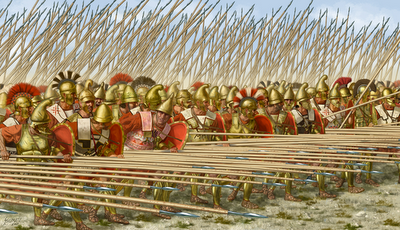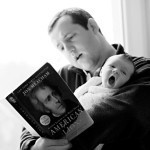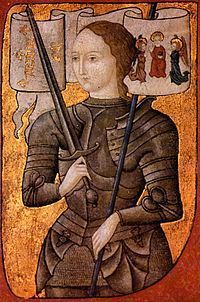Michael Rank's Blog, page 19
September 23, 2013
HFM 034 | Alexander the Great, Part 2: How He Conquered Everything Between Macedonia and India
 How did Alexander the Great practically conquer the entire known world? By six easy steps. If you can do them, then maybe the sobriquet “Great” is yours for the taking!
How did Alexander the Great practically conquer the entire known world? By six easy steps. If you can do them, then maybe the sobriquet “Great” is yours for the taking!
Like this podcast?
September 15, 2013
HFM 033 | Alexander the Great, Part 1: Myths about Alexander’s Life
[image error]
It’s almost impossible to separate Alexander the man from Alexander the myth, but we’ll give it a try. Was he really tutored by Aristotle and cut a knot in half with his sword? Yes. Did he impregnate 300 Amazonian woman to create a master race? Hopefully not.
September 13, 2013
My October-November Blog Tour for “The Most Powerful Women in the Middle Ages” Has Been Scheduled!
Viking Slayers, From Empress Theodora to Elizabeth of Tudor
by Michael & Melissa Rank
About The Authors

Melissa Rank writes extensively on intercultural communication and health on her blog http://hungaryforturkey.wordpress.com. An avid traveler, she has taught English as a Second Language in many countries, including Indonesia, Turkey, Hungary and Rwanda.
She is currently enjoying taking care of her young daughter and navigating the terrain of motherhood, and unlike many of the women in this book, has no plans of taking over the country or the world any time soon.
Michael Rank is a doctoral candidate in Middle East history. He has studied  Turkish, Arabic, Persian, Armenian, and French but can still pull out a backwater Midwestern accent if need be. He also worked as a journalist in Istanbul for nearly a decade and reported on religion and human rights.
Turkish, Arabic, Persian, Armenian, and French but can still pull out a backwater Midwestern accent if need be. He also worked as a journalist in Istanbul for nearly a decade and reported on religion and human rights.
He does his best to help out Melissa raise their daughter, whom he secretly hopes can one day be in a book like this. But he would like her to seize power without having to go through all those marriages to surly men, of course. Michael is also the author of the #1 Amazon best-seller “From Muhammed to Burj Khalifa: A Crash Course in 2,000 Years of Middle East History,” and “History’s Worst Dictators: A Short Guide to the Most Brutal Leaders, From Emperor Nero to Ivan the Terrible.”
About The Book
Genre: History | Women’s Studies
Publisher: Five Minute Books
Release Date: August 13, 2013
Buy: Amazon

The idea of a powerful woman in the Middle Ages seems like an oxymoron. Females in this time are imagined to be damsels in distress, trapped in a high tower, and waiting for knights to rescue them, all while wearing traffic-cones for a hat. After rescue, their lives improved little. Their career choices were to be a docile queen, housewife, or be burned at the stake for witchcraft.
But what if this image of medieval women is a complete fiction?
It turns out that it is. Powerful female rulers fill the Middle Ages. Anglo-Saxon queen Aethelflaed personally led armies into direct combat with Vikings in the 900s and saved England from foreign invasion. Byzantine Empress Theodora kept the empire from falling apart during the Nika Revolts and stopped her husband Justinian from fleeing Constantinople. Catherine of Siena almost single-handedly restored the papacy to Rome in the 1300s and navigated the brutal and male-dominated world of Italian politics. Joan of Arc completely reversed the fortunes of France in the Hundred Years War and commanded assaults on English fortresses despite being an illiterate 17-year-old peasant.
This book will look at the lives of the ten most powerful women in the Middle Ages. Whether it is the famed scholar Anna Komnene, who wrote the first narrative history, or Ottoman Queen Mother Kösem Sultan, who ruled the Islamic empire through three of her sons – all these women held extraordinary levels of power at a time when women were thought to not have any.
It will explore how they managed to ascend the throne, what made their accomplishments so notable, and the impact they had on their respective societies after their deaths. It will also describe the historical background of these women, their cultures, and what about it helped or hindered their rise.
Their stories still echo down to today. They are a testimony to the resiliency of individuals to accomplish extraordinary things, even if society puts on them enormous constraints.
Excerpts
part 2 excerpt
Joan of Arc (1412-1431): The Maiden of Orléans and History’s Most Lethal ‘Heretic’
“The character of Joan of Arc is unique. It can be measured by the standards of all times without misgiving or apprehension as to the result. Judged by any of them, judged by all of them, it is still flawless, it is still ideally perfect; it still occupies the loftiest place possible to human attainment, a loftier one than has been reached by any other mere mortal.” And so Mark Twain described the character of the legendary French commander in 1908 as the bravest soul in human history.
But is it true? More specifically, are the tales of her heroic deeds in fact tales, or the remarkable factual accounts of a hero remembered to this day? Much of Joan of Arc’s story is so fantastic that it approaches the outer limits of plausibility. A 17-year-old French peasant marches up to the king and demands that she be given the right to command his forces. He agrees, despite her having no education or military experience. She cuts her hair short and wears armor to appear as a man to her enemies on the battlefield.
Against all odds, she leads the army in a string of victories against the English, among the most elite fighting forces in the world. And this is an army composed of French soldiers, no less. These victories follow decades of French defeat in the Hundred Years War in which France is on the brink of annihilation. She turns the momentum of the war completely around and pushes the English off the continent. Joan is then captured and executed under trumped-up charges of witchcraft. Decades later she is declared innocent by a papal court, and centuries later canonized to become one of France’s five patron saints.
Separating fact and myth in her life is exceptionally difficult, but we have the benefit of a multitude of first-hand sources and testimonies about her life. Joan represented herself when the English put her on trial, and the entire court record survives. The Catholic Church opened a retrial years after her death to clear her of charges of heresy and interviewed over 100 of her personal acquaintances.
According to Stephen Richey’s summary of historical opinion about Joan, the interviews reveal a farm girl with an innate genius for politics and military strategy. She condensed years of learning into a matter of weeks and dealt as an equal with royalty, clerics, and battlefield commanders. As Mozart was able to intuit the workings of a piano and compose symphonies as a child, or Einstein could extrapolate relativity and quantum physics from general mathematics, Joan knew how to place artillery on the chessboard of the battlefield, lead cavalry charges at the weakest point in the enemy lines, storm a fortress, and conduct herself in military matters with as much clear-sightedness as a captain with 30 years’ experience. She also time and time again embarrassed any male commander who doubted her abilities.
Perhaps more important than her tactical brilliance, however, was her phenomenal force of will. Joan was on the front rank of every assault against the French that she ordered to be launched. Her squire Jean D’Aulon recounted that in a battle fought near the fort the Augustins, the French were withdrawing back to Orléans when the English launched a surprise attack at the rear of their column. Joan immediately arrived on the scene with the mercenary captain La Hire.
Armed with lances, the two leveled their lances and charged headlong at the enemy. They struck the first blows. The French knights and foot soldiers, emboldened by her bravery, turned and swept the English from the field. In other battles Joan was shot by enemy arrows but always returned to the battlefield in a few hours, if not immediately. At the Tourelles, Joan, with her shining armor and banner, was hit with a projectile and evacuated from the field.
The French were disheartened and the English emboldened. The tide turned once again when she returned a short time later with her wound staunched and banner raised in her good arm. Joan shouted for one more effort; the English trembled with fear while the French regained their courage for a final attack.

Follow The Tour Here
a Rafflecopter giveaway
September 9, 2013
HFM 032 | 3 Inventions That Are Much Older Than You Think
[image error]Cars, computers, and batteries are modern inventions, and before that we lived in a technological dark age, right? Not exactly. Some of your favorite inventions are much older than you thought. Find out in this podcast!
Like this podcast?
September 2, 2013
HFM 031 | The Library of Alexandria and its Destruction
[image error]The Great Library of Alexandria is believed to have housed many, if not most, of the books in the ancient world. All of the plays of Sophocles were held there, over 100, and we only have 7 that survive today. What did we lose by its destruction, and who burned it down?
Like this podcast?
August 26, 2013
HFM 030 | The Most Powerful Women in the Middle Ages, Part 3: Queen Elizabeth of Tudor
[image error]Queen Elizabeth of Tudor is considered the greatest queen of England. Learn how she defeated the Armada, funded Shakespeare, and forged an English identity in this podcast.
Like this podcast?
August 19, 2013
HFM 029 | The Most Powerful Women in the Middle Ages, Part 2: Joan of Arc (1412-1431): The Maiden of Orléans and History’s Most Lethal ‘Heretic’
 Joan of Arc has one of the most incredible stories in history. How did an illiterate peasant lead an army into victory against England in the Hundred Years War? Learn about her upbringing, her visions from God, how she learned years of military strategy in a matter of weeks, and why she convinced King Charles VII to give her command of the army even though she had no combat experience.
Joan of Arc has one of the most incredible stories in history. How did an illiterate peasant lead an army into victory against England in the Hundred Years War? Learn about her upbringing, her visions from God, how she learned years of military strategy in a matter of weeks, and why she convinced King Charles VII to give her command of the army even though she had no combat experience.
Like this podcast?
August 15, 2013
New book “The Most Powerful Women in the Middle Ages” has launched! Discounted to $0.99 for a limited time
 “The Most Powerful Women in the Middle Ages” is my exciting new book about great female monarchs such as Joan of Arc, Elizabeth I, Theodora, Margaret I, Catherine of Siena, and many more.
“The Most Powerful Women in the Middle Ages” is my exciting new book about great female monarchs such as Joan of Arc, Elizabeth I, Theodora, Margaret I, Catherine of Siena, and many more.
The idea of a powerful woman in the Middle Ages seems like an oxymoron. Females in this time are imagined to be damsels in distress, trapped in a high tower, and waiting for knights to rescue them, all while wearing traffic-cones for a hat. After rescue, their lives improved little. Their career choices were to be a docile queen, housewife, or be burned at the stake for witchcraft.
But what if this image of medieval women is a complete fiction?
It turns out that it is. Powerful female rulers fill the Middle Ages. Anglo-Saxon queen Aethelflaed personally led armies into direct combat with Vikings in the 900s and saved England from foreign invasion. Byzantine Empress Theodora kept the empire from falling apart during the Nika Revolts and stopped her husband Justinian from fleeing Constantinople. Catherine of Siena almost single-handedly restored the papacy to Rome in the 1300s and navigated the brutal and male-dominated world of Italian politics. Joan of Arc completely reversed the fortunes of France in the Hundred Years War and commanded assaults on English fortresses despite being an illiterate 17-year-old peasant.
This book will look at the lives of the ten most powerful women in the Middle Ages. Whether it is the famed scholar Anna Komnene, who wrote the first narrative history, or Ottoman Queen Mother Kösem Sultan, who ruled the Islamic empire through three of her sons – all these women held extraordinary levels of power at a time when women were thought to not have any.
It will explore how they managed to ascend the throne, what made their accomplishments so notable, and the impact they had on their respective societies after their deaths. It will also describe the historical background of these women, their cultures, and what about it helped or hindered their rise.
Their stories still echo down to today. They are a testimony to the resiliency of individuals to accomplish extraordinary things, even if society puts on them enormous constraints.
It is now available on Kindle right now, and you can get it by clicking here. It is only 99 cents for a limited time. Hope you enjoy!
August 12, 2013
HFM 028 | The Most Powerful Women in the Middle Ages, Part 1: Lady Aethelflaed of the Mercians (872-918): The Real-Life Eowyn of Rohan and Viking Slayer
[image error]Eowyn of Rohan from the “Lord of the Rings” is based on a real person, but she was far more fericious! Learn about Lady Aethelflaed, ruler of England in the 900s and slayer of Vikings. This is the first in a three-part series on the most powerful women in the Middle Ages.
Like this podcast?
HFM 027 | The Most Powerful Women in the Middle Ages, Part 1: Lady Aethelflaed of the Mercians (872-918): The Real-Life Eowyn of Rohan and Viking Slayer
[image error]Eowyn of Rohan from the “Lord of the Rings” is based on a real person, but she was far more fericious! Learn about Lady Aethelflaed, ruler of England in the 900s and slayer of Vikings. This is the first in a three-part series on the most powerful women in the Middle Ages.
Like this podcast?



